فهرست مطالب

Social Determinants of Health
Volume:3 Issue: 1, 2017
- تاریخ انتشار: 1396/01/08
- تعداد عناوین: 5
-
-
Page 3IntroductionStress occurs when the external events and happenings those are beyond the adjustment capabilities of the individual and he considers it as an unpleasant event. Occupational stress is a kind of stress that a person is undergoing doing certain jobs, and it is caused by the interaction between working conditions and demographic characteristics of the employee. The signs of occupational stress include mental, physical, and behavioral symptoms. Given the role of the health professionals responsible for preventive care services in our health system, it was decided, in this study, to determine the occupational stress in the staffs of the health centers in Yazd.Materials And MethodsIn this cross-sectional descriptive study, the staffs of the health centers in Yazd were studied using census method through standard occupational stress questionnaire (HSE), and a total of 237 questionnaires were collected. Moreover, the obtained information was analyzed through SPSS 20 software.ResultsThe mean score of occupational stress in individuals was calculated as 91.53 ± 13.51. There was no statistically significant relationship between the occupational stress and Age (P.value = 0.7), gender (P.value = 0.24), marital status (P.value = 0.08), and educational level (P.value = 0.19). On the other hand, the rate of occupational stress was significantly associated with work experience (P. value = 0.04).ConclusionThe findings of this study indicated that 54.1% of the participants were very unfavorable and undesirable in terms of occupational stress. Greater frequency percentage of the individuals in unfavorable and very unfavorable categories in communication and variation scale, compared to the other subscales, revealed some problems in the organizations and variations of the organization forces as well as the need for an increase in practice and positive characteristics to increase mass communication and reduce conflict in the workplace.Keywords: occupational stress, the staffs of the health centers, HSE questionnaire
-
Study of Alexithymia among People with Low Distress Tolerance Compared to Non-clinical SamplePage 6The present research was aimed at studying Alexithymia among people with low distress tolerance in comparison to non-clinical sample. The research population consisted of all male employees working for General Education Office of Kermanshah Province,(Iran)300of whom were selected based on Morgan table by multistep clustering method, to whom demographic data questionnaire, Toronto alexithymia scale, and distress tolerance questionnaire were distributed. The research data was analyzed by SPSS 19 by running independent-group T-test method. The results of the study revealed that Alexithymia was significantly relation between the groups with low distress tolerance in comparison to the group of normal subjects at 3 levels of feelings: description disorder, feelings recognition disorder, and superficial thinking.
-
Page 9BackgroundTesticular Cancer (TC) is the most common cancer among men between 20 and 40 years old. Treatment for TC is highly effective when detected before the metastatic stage. Although screening of TC through self-examination is recommended, it seems that many men do not do self-examination routinely, so the current study aimed to evaluate the Theory of Planned Behavior (TPB) as a framework for considering Testicular Self-Examination (TSE) intention among a sample of 20- to 34-year-old men.
MethodsA cross-sectional study was designed and 50 young men were randomly selected. A questionnaire was administered to young men, referring to one of the hospitals in Tehran in 2016. The data were analyzed using SPSS software 16 (SPSS Inc., Chicago, IL, USA), running descriptive tests, chi-square, Pearson correlation, and linear regression analysis.
ResultsMean (SD) age of participants was 30 (3.77) years old. The majority were married (29), followed by single (19), divorced (2). The correlation tests showed a statistically significant relationship between self-efficacy with intention (PConclusionThe structures of TPB might be useful for increasing TSE. So, educational interventions based on TPB could be effective for the primary prevention of testicular cancer. -
Page 15BackgroundDivorce is a complex, multivariate concept and it affects thousands of people in Iran each year. However, the concept of post-divorce adjustment in Iranian women has not been dealt with in depth. The aim of this qualitative study was to understand the factors contributing to post-divorce adjustment in divorced women.Methods21 divorced women were selected using purposive and network sampling and were studied using the ground theory analysis. Semi-structured interviews were conducted, recorded and transcribed for further analysis.ResultsThe result showed that there are six categories of the main factors contributing to post-divorce adjustment: (a) demographics, (b) Interpersonal, (c) attitudinal, (d) Relational, (e) supportive, (F) coping strategies.ConclusionWith respect to the finding in this research and the number of people experiencing divorce each year, these results indicate the importance of supportive programs and interventions targeting the lives of women after divorce.

